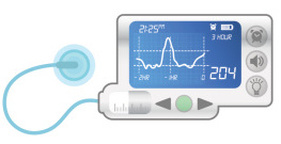Insulin Pumps
How do they work?
"An insulin pump is a device about the size of a cell phone that contains a cartridge of rapid-acting insulin. A pump has a screen and buttons for programming the pump’s internal computer, and a precise motor that pushes the insulin from the cartridge into your body through a thin plastic tube called an infusion set."
- Animas
The Benefits of Using an Insulin Pump
Insulin pumps have many more benefits than they do disadvantages. They have proven to regulate a better "HbA1c result, fewer hypoglycemic events, reduction in glycemic variability and improved quality of life", (Medtronic Diabetes).
These machines provide the user with easier dosing, fewer injections, greater flexibility and more convenience.
These machines provide the user with easier dosing, fewer injections, greater flexibility and more convenience.
Easier Dosing:
Easier dosing is available due to the pre-installed calculators that enable the user to calculate the insulin that is required at given situations. Certain pumps also ensure accurate dosing by taking into account the insulin that is already in the body (and still working) and some also check for blood glucose levels. Overall, insulin pumps are an advantage to have because the user can log in their carbohydrate intakes, their carb per unit of insulin ratio, and personal insulin settings, which all help when determining the right insulin doses to take.
Fewer Injections:
When using an insulin pump, the user has an infusion set with a catheter that delivers fast-acting insulin whenever needed. This catheter is changed 2 to 3 days after using. On the other hand, if a diabetic is not on the pump, they have to inject insulin every time they eat and every time their BG levels are high.
Greater Flexibility:
An insulin pump can be easily used while practicing any type of sport, as there are special bands that allow the user to keep the pump safely attached. Moreover, these machines can also be easily adjusted during sick days "or to deliver small boluses to cover meals and snacks", (Medtronic Diabetes). By just touching a button, a diabetic can inject insulin, instead of taking injections every time it is needed.
More Convenience:
Some insulin pumps also have a glucose meter that constantly checks glucose values and sends them to the pump, which is convenient for better insulin calculations. Other pumps also store all information into a digital logbook that can then be viewed by the endocrinologist, if necessary.
|
Insulin pumps are very fragile and are not successful for everybody. They are also very costly: anywhere from $5,000-$7,000, unless covered by health insurance. However, they can really be a GREAT OPTION for some (if not most) people!
My Experience... My experience with the Animas insulin pump was not successful, but I know people who's experience has been the best it could have been and it has completely changed their life in a positive way. In regards to my usage of the Animas pump, the catheters would not stick to my skin for a long period of time and they would get infected. I would also have to change the catheter every other day, if not, every day, which was very painful. The needles were thick, and therefore, it would hurt. It would also often fall out or the thin tube would not deliver the insulin due to a blockage. After experiencing this for a year and a half, I decided to get off the pump and just use my insulin pen to inject myself every time it's needed instead. Although the first six months with the pump were well, the rest of the time I used it was not. This is why I decided that getting off it was what was best for me, my body, and my skin. However, I definitely recommend other diabetics to try out an insulin pump if possible.
|
Fun Fact:
|






